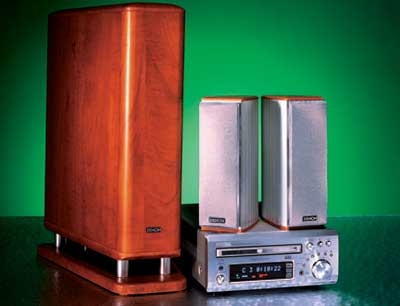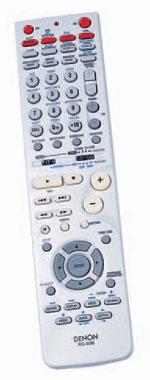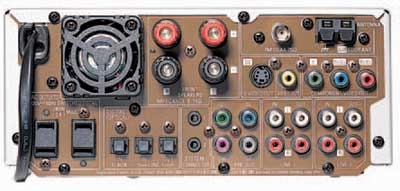Home Theater Made Easy Page 4
Denon D-M71DVSXA home theater setup with just two main speakers might seem like a step backward, but Denon's $999 D-M71DVSXP is the first A/V system to use Dolby's Virtual Speaker (VS) technology to simulate five-channel surround sound. You can buy the system without its powered subwoofer, but you'll need the sub's support for playing DVDs or hot audio CDs. Even the cleverest virtual surround needs something real to stand on. The main unit has center- and surround-channel preamp outputs in case you want to upgrade to six discrete speakers. 
| DENON D-M71DVSXP |
| • DIMENSIONS (WxHxD, inches) DVD player/receiver 8 3/8 x 3 3/4 x 14 3/4 L/R speakers 2 3/4 x 8 3/8 x 6 3/8 subwoofer 9 1/8 x 18 1/8 x 15 3/4 • SYSTEM WEIGHT 32 pounds • PRICE $999 • MANUFACTURER Denon Electronics, www.usa.denon.com, 973-396-0810 |
The half-size receiver/DVD player has a somewhat unconventional shape, like a flattened shoebox, with 11 controls at one end that operate all of its functions. There's a headphone jack on the front panel, and Dolby Headphone virtual surround processing is provided so you don't have to give up multichannel excitement when you turn the speakers off.
All the information you need is displayed on both the main unit's front panel and on your TV screen. The imposing 70-key universal remote, preprogrammed to control just about any A/V component, is intelligently laid out, with buttons differentiated by size, shape, and color - the most important ones glow in the dark. It's by far the best remote in this trio of systems.
The satellite speakers and subwoofer are shaped like rounded, elongated triangles, but the narrow end faces forward on the sub while the wide ends face forward on the satellites. The satellites are equally handsome with their drivers exposed or hidden behind silvery woven grilles. The knee-high sub, completely enclosed in a simulated wood cabinet that matches the satellites' end caps, aims its down-firing woofer at a wood base, which disperses the sound.
 Video from the D-M71DVSXP looked very good, with no glitches as the camera rapidly panned and the horses flew by in Seabiscuit. The player operated smoothly and responded rapidly to commands from the remote.
Video from the D-M71DVSXP looked very good, with no glitches as the camera rapidly panned and the horses flew by in Seabiscuit. The player operated smoothly and responded rapidly to commands from the remote.
On the audio side, I was impressed from the first notes of Randy Newman's score. Considering the system's modest 20-watt-per-channel power rating - even augmented by the 100-watt subwoofer - it played surprisingly loud, with no distortion.
Voices sounded natural and authentic. The narrator's baritone resonated smoothly, and the music, which includes a brass band and plenty of "oompah," sounded firm and robust. In the treble range, the triangle the radio announcer rings for effect sparkled almost as if it was in the room, yet without annoying brightness.
Of course, the system's drawing card is Dolby VS processing. Whether made up of sounds from nature like rustling grass, a crackling campfire, and birds, or city sounds like streetcars, sputtering car engines, and general urban noise, the sound fields of Seabiscuit surrounded me, convincingly filling my room. In some respects the sound was better than from a six-speaker setup because I couldn't pinpoint the source of these ambient effects. While foreground sounds, like the roar of the fans, didn't completely surround me, they filled the front half of the room, while the dialogue stayed centered onscreen.
Denon lets you adjust the "spread" of Dolby VS using either the default Reference mode or the Wide mode. I preferred Wide because it accentuated the breadth of the sound field without making it seem gimmicky. The sweet spot for VS was so small, however, that I had to sit more or less in an equilateral triangle with the speakers. But I was pleasantly surprised when listening to CDs by the depth of sound revealed by the VS processing. I give Dolby VS a definite two-ears-up. Even with it turned off, the system's two-channel stereo imaging placed vocalists in a natural perspective, with the instruments properly placed across the soundstage. 
But as good as Dolby VS sounds and the Denon system performs, the combination just can't play as loud as a full-fledged multichannel setup nor deliver all the nuances one of those can - and it shouldn't be expected to. If you're pressed for space, though, the D-M71DVSXP unquestionably provides an impressive experience.
By combining a DVD recorder and a traditional sub/sat speaker system, the Panasonic SC-HT1000 gives great value. The changer and wireless surround speaker in Pioneer's HDT-630DV are convenient, but that speaker works better for music around the house than as a substitute for discrete surrounds. And if you just can't stand lots of wires, Denon's use of Dolby VS in the D-M71DVSXP makes a good alternative. But in a photo finish, Panasonic wins by a nose. PDF: Key Features PDF: In The Lab
- Log in or register to post comments





























































